Jobs-to-be-Done (JTBD) is best defined as a perspective — a powerful lens through which companies can observe markets, customer needs, competitors, and market segmentation differently, and in doing so, make their success at innovation far more predictable and profitable. Companies look at the world of innovation through this lens to accelerate their growth.
The theory goes on to say that to create products and services that are likely to win in the marketplace, companies must make their customer's jobs-to-be-done the unit of analysis, work to gain a deep understanding of those jobs, and then create offerings that will help customers get their jobs done significantly better and/or more cheaply.
Making the job the unit of analysis, rather than the product or the customer, opens the door to new possibilities. While products come and go, the customer’s job-to-be-done remains stable over time, providing companies with a stable focal point for their value creation efforts.
If cassette tape, CD and MP3 manufacturers focused on the job of "listening to music" instead of the technology, they may have avoided disruption. Maintaining market leadership means staying focused on helping people get more of the job done — and helping them get it done better and cheaper.

With a focus on the job-to-be-done, the world looks different. A market becomes a group of people trying to get a job done. Customer needs become the measurable outcomes they are trying to achieve. A new language of innovation emerges — one that is helping companies take the randomness and risk out of their innovation initiatives.
JTBD Theory is comprised of a set of tenets, each of which reveals a unique aspect of the theory. Collectively, the tenets offer a foundation upon which an organization can reinvent its approach to marketing and innovation..
The nine tenets of JTBD Theory: building blocks for predictable growth.
People buy products and services to get a “job” done.
Jobs are functional — with emotional and social components.
A job-to-be-done is stable over time.
A job-to-be-done is solution agnostic.
Success comes from making the job the unit of analysis, rather than the product or the customer.
A deep understanding of the customer’s job makes marketing more effective — and innovation far more predictable.
People want products and services that will help them get a job done better and/or more cheaply.
People seek out products and services that enable them to get the entire job done on a single platform.
Innovation becomes predictable when “needs” are defined as the metrics customers use to measure success when getting the job done.
These tenets detail a sound and proven theory because they are based on evidence, verification and repeated testing by the Strategyn team. The world’s most sophisticated companies are relying on them to successfully accelerate their innovation efforts.
Putting Jobs-to-be-Done Theory into practice enables companies to adopt a common language of innovation and transform their innovation processes from an art to a science. Most notably, applying JTBD allows companies to:
BREAK DOWN FUNCTIONAL SILOS AND ALIGN TEAMS.
With Jobs-to-be-Done, all functions in the business can align around a common understanding of the customer’s needs and how to create value for that customer.
CREATE WINNING PRODUCTS.
Jobs-to-be-Done offers a new framework and lens through which a company can take its understanding of customer needs to the next level — and bring predictability to innovation.
COMMUNICATE OFFERINGS EFFECTIVELY.
Jobs-to-be-Done helps marketers align the entire organization around a clear and consistent messaging strategy that strongly resonates with customers.




Design Thinking is often implemented as a box of tools that developers can use to effectively develop a product, i.e., develop the product correctly.
Jobs-to-be-Done is a lens that product planners, innovators and strategists can use to make sure developers are developing the right product to begin with.
Companies that are putting Jobs Theory into practice are using it as a lens to determine:
These insights allow innovators to conceptualize product and service offerings that address specific customer segments and unmet needs. Using this approach, innovators are far more likely to define a concept that they can be certain will win in the marketplace — before the development effort even begins. Jobs-to-be-Done helps companies do the right things, while Design Thinking and agile development help development teams do things right.

Winning at innovation means targeting the right market, understanding the customer’s needs, discovering segments of customers with different unmet needs, and addressing the targeted needs with solutions that get the job done significantly better.
Strategyn has created four Jobs-to-be-Done Frameworks that will guide you through each step of the process. They will help you get started on the right foot and avoid the pitfalls that often derail innovation efforts.
Market definition is often random and left to chance. Define it as a group of people trying to get a job done.
Begin the needs discovery process with a deep understanding of what the customer is trying to accomplish at each step in the job.
Gain clarity on the 3 types of customers, the 5 types of jobs and what inputs are needed to bring predictability to innovation.
Know when to employ differentiated, dominant, disruptive, discrete, and sustaining strategies to win in the marketplace..
Companies use various, seemingly random classification schemes to define the markets they serve. We’ve seen innovators choose to define markets around products, demographics, personas, use cases, geographies, and more. The point is, when the market definition process is obscure, random, and left to chance, innovators can inadvertently choose to define markets in ways that causes them to churn, pivot and fail. There is a solution: define a market as a group of people and the job they are trying to get done.
Defining a market around the job-to-be-done provides a stable, long-term focal point around which companies can create value.
The JTBD Market Definition Canvas, below, helps the innovator move from a product mindset to a problem mindset while defining the market being served.
The benefits are far-reaching: a market defined through a JTBD lens is stable over time, actionable, and dramatically simplifies the needs discovery process. The canvas is recommended for use in the Lean Startup community by Steve Blank.
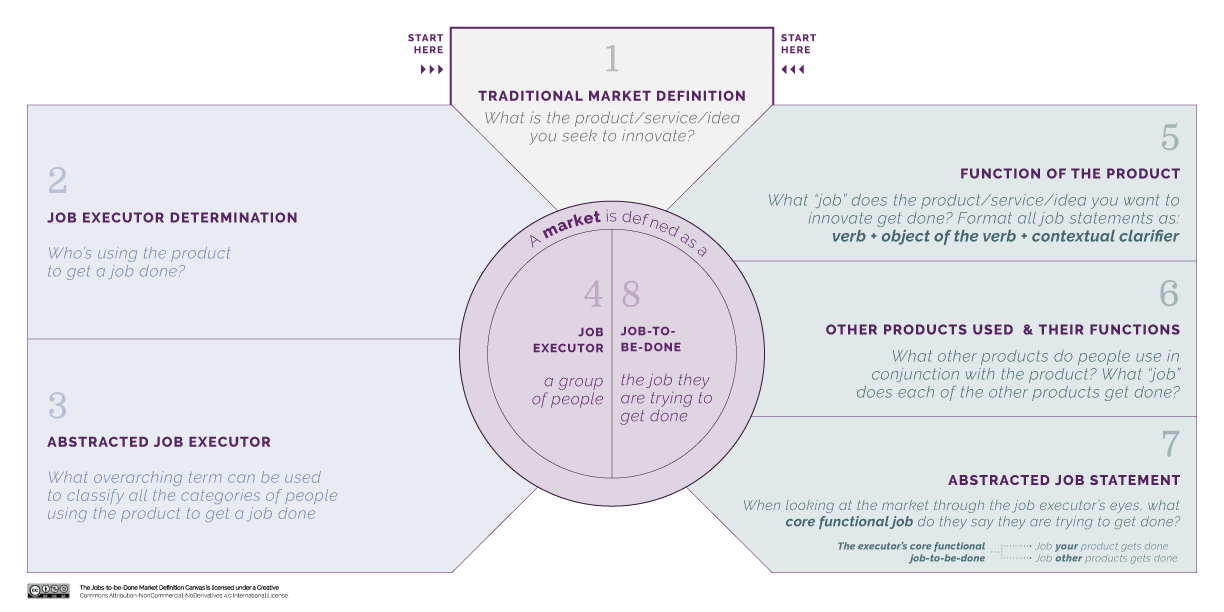
Understanding customer needs through a Jobs-to-be-Done lens begins with the creation of a job map. A job map is not a process map or a customer journey map. It does not describe what the customer is doing. Rather, it depicts what the customer is trying to get done, in the ideal order, for efficient execution. The job map reveals opportunities to help customers get their job done better and provides a structure for needs gathering.
All jobs are comprised of steps that can be universally classified into 8 categories:
A job map provides customer insights at the 10,000-foot level — and the structure to understand customer needs at a very granular level. The concept of job mapping was first introduced by Strategyn in the 2008 Harvard Business Review article, “The Customer-Centered Innovation Map.”
This Needs Framework helps companies define, categorize, capture and organize all the customer's needs. It introduces the 3 types of customers to consider and the 5 types of jobs that exist. It explains what inputs must be captured from each customer type to gain a complete understanding of customer needs in a market.
When studying the customer’s job-to-be-done, customer needs are best defined as the measurable outcomes they are trying to achieve as they execute each step in the job. In most markets, customers can express well over 100 distinct outcomes. Using this framework, a complete set of needs can be captured in days and used for years to come, as both the needs and the job-to-be-done are stable over time.
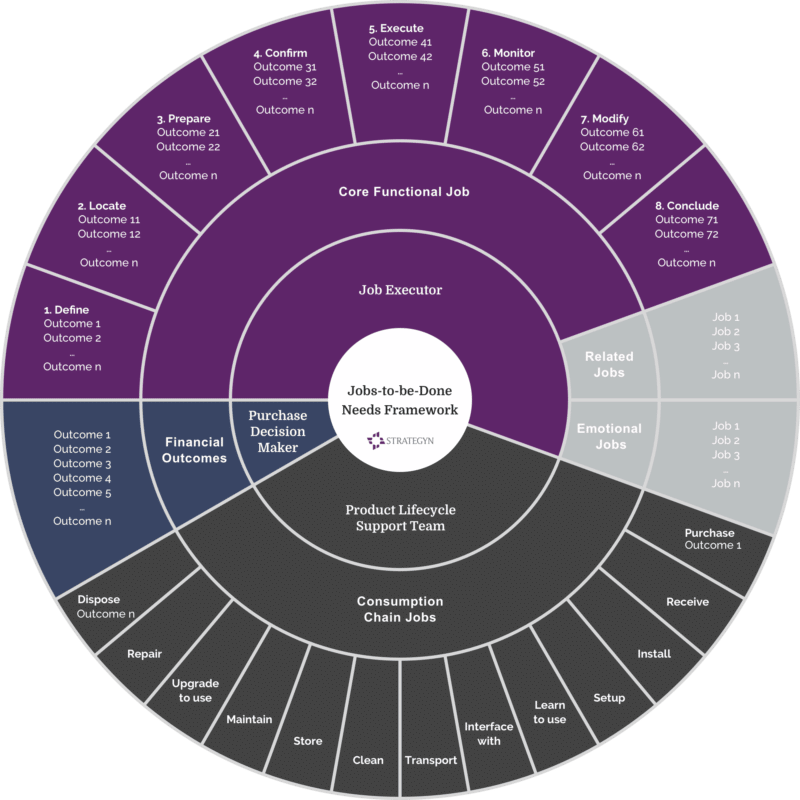
Our research shows that in over 90% of all product teams there is disagreement on what a customer “need” even is. This is the root cause of failure in innovation.
Understanding the customer’s needs is far more effective when:
With a deep understanding of the customer’s JTBD and their measurable outcomes, the innovation process becomes far more predictable.
The goal of innovation is to help customers get a job done better and/or more cheaply. The JTBD Growth Strategy Matrix ties 5 common strategies to this construct and explains what each strategy is, why and when it should be pursued, and the prerequisites for success. It takes the theory of disruptive innovation to the next level.
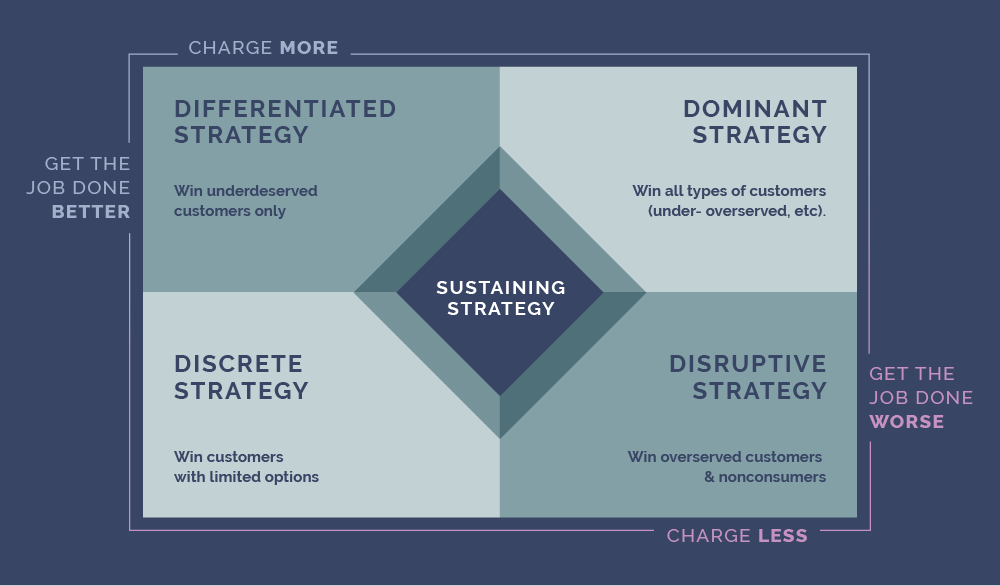
This Jobs-to-be-Done Growth Strategy Matrix reveals when you should pursue disruptive, sustaining, differentiated, dominant and discrete strategies to win in a market segment.
A differentiated strategy is effective when targeted at a customer population that is underserved and willing to pay more to get the job done better.
This strategy requires a solution that gets the job done both better and more cheaply. Pursuing such a strategy is nearly always effective, as it targets underserved and overserved segments and non-consumers.
A disruptive strategy is effective when targeted at a customer population that is overserved and not willing to pay more to get the job done better. This strategy also appeals to non-consumers.
This strategy only appeals to customers who find themselves in situations where limited or no alternative solutions are available.
A sustaining strategy works when targeting a customer population that has very few underserved or overserved needs. While it’s usually a poor strategy for a new market entrant, it is often used by incumbents to retain customers.
Kettle makers offer a prime example of how JTBD works in practice. As a kettle maker, it would be easy to conclude that people buy your product to boil water. But boiling water is just a step in the real job the customer is trying to get done — which is to prepare a hot beverage for consumption.
If the business keeps making kettles without focusing on the entire job, they are at risk of disruption by a competitor with a solution that gets the entire job done on a single platform (like Keurig). It is not uncommon for a new competitor to overtake a market by finding the resources, funding and technology, and developing the know-how and capabilities to create an offering that gets the entire job done.
There are plenty of examples of businesses that have used Jobs-to-be-Done and Outcome-Driven Innovation to achieve phenomenal growth.
Cordis Corporation was struggling to survive in the angioplasty balloon market. They discovered a dozen outcomes that were underserved and created products to address them. Cordis released 19 new products, all of which became number 1 or 2 in the market ,and their market share increased from 1% to over 20%. Read more.

Bosch successfully entered the mature and competitive circular saw market after discovering a unique segment of customers (finish carpenters) with significant unmet needs. By solving for these needs, Bosch’s innovations resulted in a highly successful product launch and dramatic improvements in customer satisfaction. Upon introduction, Popular Science voted the CS20 circular saw one of the top innovative products of the year. Read more.

Microsoft was under pressure to build additional value into their Software Assurance offering — and they needed innovative ideas to give customers more reasons to buy. With a more complete understanding of the jobs their customers were trying to accomplish, they were able to package their offerings in a more cohesive and compelling offering, which doubled year-over-year revenue. Read more.
In 1990, Tony Ulwick invented a powerful innovation process based on the notion that people buy products and services to get a “job” done. The process helped companies discover and address the measurable outcomes customers try to achieve when getting a job done, making the innovation process far more predictable. Read the full history of Jobs-to-be-Done.
In 1991, after a decade of successes applying his approach, Tony introduced the Outcome-Driven Innovation process and its underlying theory to Harvard Business School professor Clayton Christensen as a possible solution to the innovator’s dilemma. Clayton helped popularize this theory by introducing it in his 2003 book, The Innovator’s Solution, citing Tony’s work. He called the theory “jobs-to-be-done” and over time the name stuck. See Clayton thank Strategyn for introducing him to these concepts in this video.
After witnessing a product failure first-hand at IBM in 1984, Tony hypothesized that if a company knew in advance precisely how their customers measure success when trying to get the job done it would dramatically increase the company’s chances for success at creating winning products.
Tony founded Strategyn in 1991. His first major success using his methodology came in 1992 when he helped Cordis Corporation reinvent its line of angioplasty balloon products. Cordis’ market share increased from 1% to more than 20%, and the company’s stock price more than quadrupled.
Over the years, Strategyn has applied its methodology in over 1000 markets and across nearly all industries, creating billions of dollars in new revenue growth for its clients. As the pioneers of Jobs Theory and the creators of the Outcome-Driven Innovation process, Strategyn is uniquely qualified to help your company accelerate growth through innovation.
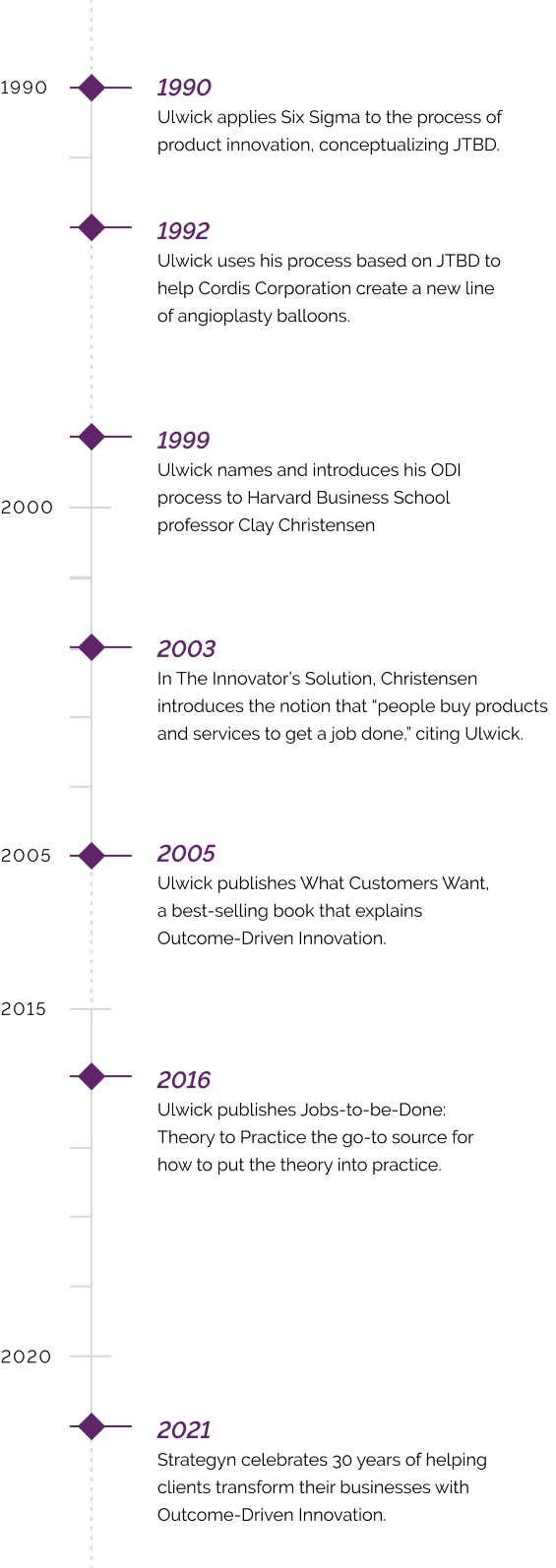
There are a variety of resources available to help innovators learn how to put Jobs-to-be-Done Theory into practice. Get started today.
Strategyn also offers a guided approach to your learning. Our Jobs-to-be-Done training courses are designed to help you apply Strategyn’s ODI process to a market of interest. As you learn ODI, you will gain new insights into your markets and discover how to devise breakthrough solutions.
COURSE BENEFITS:
On-Demand course structure
Personalized Q&A sessions with an innovation practitioner
Certification
Jobs-to-be-Done Book
Tony Ulwick’s JOBS TO BE DONE: Theory to Practice book is the most popular book on JTBD. Download a copy of the e-book and audio book for free. The book offers a thorough explanation of Jobs-to-be-Done Theory and how it can be put into practice using the ODI process.
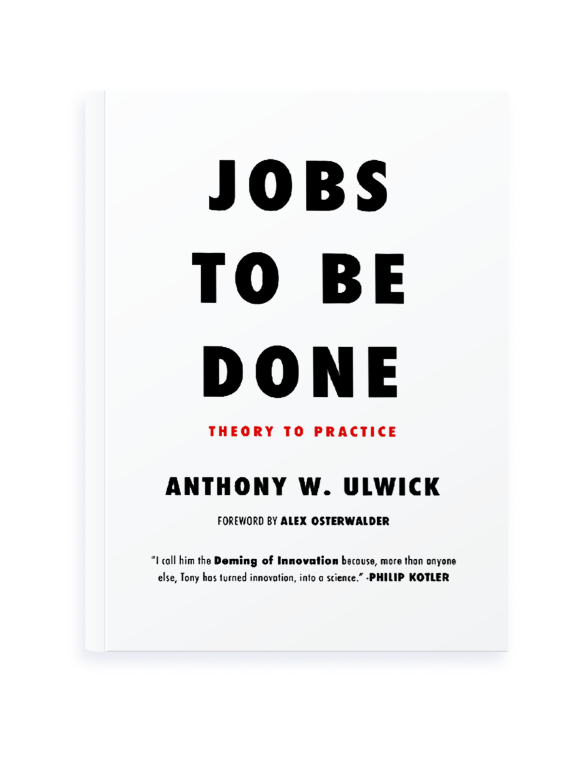
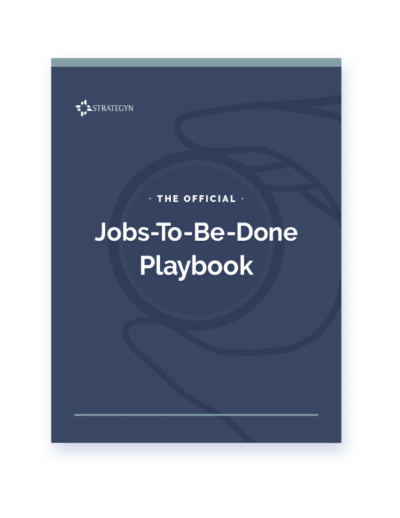
The Official JTBD Playbook
Are you looking to get started? The Official Jobs-to-be-Done Playbook will help you jump start your innovation initiative. The Playbook helps you::
Understand JTBD
Define the markets you serve
Build a job map
Put JTBD into practice
To practically apply the Jobs-to-be-Done (JTBD) framework in your organization, you should follow a structured approach, such as the Outcome-Driven Innovation (ODI) process. This involves several key steps: First, define your customer and their primary job-to-be-done.
Working directly with customers to understand their goals is crucial, rather than focusing on your product. This step helps to uncover all related jobs and desired outcomes. Once you have a clear understanding of the job, you can identify and categorize customer needs, including functional, emotional, and social jobs. The next step is to segment the market based on these needs to find opportunities for innovation.
After this, formulate a value proposition that directly addresses the identified unmet needs. Conduct a competitive analysis to understand how well current solutions meet these needs. Use this information to craft a strategy that leverages your strengths and addresses market gaps. This structured approach not only aligns innovation with customer needs but also ensures that every team within the organization is on the same page, leading to more effective and predictable innovation outcomes.
Real-world success stories highlight the effectiveness of the JTBD framework. For instance, companies like Microsoft, Arm & Hammer, and Bosch have successfully implemented the ODI process. Microsoft used it to identify and address specific customer needs, leading to the development of more targeted and successful products.
Similarly, Bosch applied the JTBD framework to innovate in the automotive sector, leading to significant advancements and market success. These case studies demonstrate that by focusing on the specific jobs customers are trying to get done and aligning product development efforts with these jobs, companies can achieve higher success rates and deliver products that better meet customer expectations.
When comparing the JTBD framework to other innovation methods like Design Thinking or Lean Startup, it is essential to understand the unique strengths of each approach. The JTBD framework is particularly powerful in its focus on understanding and categorizing customer needs based on the jobs they are trying to accomplish. This differs from Design Thinking, which emphasizes empathy and iterative prototyping, and Lean Startup, which focuses on rapid testing and learning.
While all these methods aim to foster innovation, JTBD provides a structured way to identify and prioritize unmet needs, which can be integrated into other approaches to enhance their effectiveness. For instance, insights from JTBD can inform the empathy phase in Design Thinking or guide hypothesis generation in Lean Startup. By combining these approaches, companies can create a robust innovation process that leverages the strengths of each framework.
Copyright ©2024 Strategyn LLC. All Rights Reserved. | XML Sitemap | HTML Sitemap